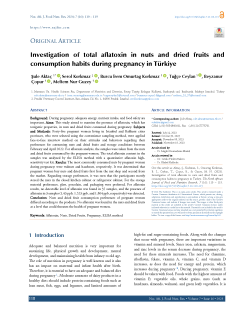Investigation of total aflatoxin in nuts and dried fruits and consumption habits during pregnancy in Türkiye
Abstract
Background: During pregnancy, adequate energy, nutrient intake, and food safety are important. Aims: This study aimed to examine the presence of aflatoxin, which has toxigenic properties, in nuts and dried fruits consumed during pregnancy. Subjects and Methods: Forty-five pregnant women living in Istanbul and Balikesir cities provinces, who were selected using the convenience sampling method, were applied face-to-face interview method on their attitudes and behaviors regarding their preferences for consuming nuts and dried fruits and storage conditions between February and April 2022. For aflatoxin analysis, the samples were taken from the nuts and dried fruits consumed by the pregnant women. The total aflatoxin content in the samples was analyzed by the ELISA method with a quantitative aflatoxin high-sensitivity test kit. Results: The most commonly consumed nuts by pregnant women during pregnancy; were walnuts and hazelnuts, respectively. It was determined that pregnant women buy nuts and dried fruits first from the nut shop and second from the market. Regarding storage preferences, it was seen that the participants mostly stored the nuts in the closed kitchen cabinet or refrigerator cabinet. For the storage material preferences, glass, porcelain, and packaging were preferred. For aflatoxin results, no detectable level of aflatoxin was found in 35 samples, and the presence of aflatoxin in 3 samples (1.43 ppb, 1.523 ppb, and 1.804 ppb, respectively) was detected. Conclusion: Nuts and dried fruit consumption preferences of pregnant women differed according to the products. No aflatoxin was found in the nuts and dried fruits at a level that could threaten the health of pregnant women.
Full text article
Authors
Copyright (c) 2023 Şule Aktaç, Serol Korkmaz, Burcu İrem Omurtag Korkmaz, Tuğçe Ceylan, Beyzanur Çöpür, Meltem Nur Güzey

This work is licensed under a Creative Commons Attribution 4.0 International License.
-
Attribution — You must give appropriate credit, provide a link to the license, and indicate if changes were made. You may do so in any reasonable manner, but not in any way that suggests the licensor endorses you or your use.
-
No additional restrictions — You may not apply legal terms or technological measures that legally restrict others from doing anything the license permits.





